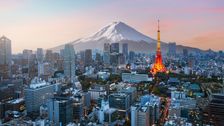
Since Japan reopened its borders to foreign tourists in October, many travelers have taken advantage of the opportunity to visit this bucket-list destination. Tokyo, the capital city of Japan, is especially popular, and for good reason ― the striking skyline, incredible food scene and treasure trove of unique cultural experiences are unforgettable.
But as tourists pour back into Tokyo, they inevitably make a few common mistakes. We asked locals and other experts to share some of the issues they’ve observed. From dining mishaps to problematic cultural assumptions, here are 14 mistakes tourists often make while visiting Tokyo ― and some advice for avoiding these errors during your travels.
Not Using Public Transportation
“Tokyo has an extensive and incredible public transportation system of subways and trains. Don’t be afraid to brave the subway system. Get yourself a prepaid subway card, like Suica or Pasmo, for easy entrance into the subway. Google Maps will tell you which lines to take and where to transfer if you need to! Be mindful, Japanese people are generally quiet on the subway, and don’t eat or drink while riding!” ― Danny Taing, founder of the Japanese snack subscription box Bokksu
Assuming Everyone Speaks English
“While you can get around with English in some tourist areas, it’s not widely spoken by the majority of Tokyo residents. Try to learn a few simple phrases, or utilize translation apps to bridge the language barrier and show effort. Learning a simple ‘hello’ or ‘thank you’ can go a long way!” ― Taing
Thinking Attractions Are Closer Than They Are
“I think that the most common mistake international travelers make in Tokyo is getting lost in the city, especially in a subway station. Since popular places such as Asakusa and Harajuku are spread out over Tokyo (not concentrated on one main street, as in many countries), many of my readers say it was hard for them to plan their trip. In the city, I see some international travelers stunned and overwhelmed in front of the map board in the stations. There are 142 stations of Japan Railway (JR) and 286 subway stations in Tokyo! It is unnecessary to learn all of the Tokyo map. I always advise future visitors to decide where in Tokyo they want to visit, first of all. It enables them to find out how to get to the places in advance and how to get there from their accommodation. Even Tokyo locals don’t know all the stations. By concentrating on the places they want to go, planning their trip becomes much easier.” ― Kozue Mitani, creator of Tokyo Direct Guide
Activating Your JR Pass Upon Arrival
“There’s often a big line of tourists waiting to activate their JR Pass at the airport right after they have arrived. It’s a waste using up a rail pass day for the short journey into Tokyo, better to activate just before you embark long distance travel, especially so with the upcoming price hike.” ― Chris Kirkland, co-founder of Tokyo Cheapo
Staying Far From Where You Want To Go
“I repeatedly advise my readers to book a hotel that is located in a convenient place for each individual’s wish list. For example, staying in Shinjuku will be a great idea if your interest is in Harajuku (just five minutes by JR Yamanote Line train!) and Shibuya (seven mins by Yamanote train, it’s so easy), but not Asakusa and Tokyo Skytree. You’ll need to change trains in the spider-web-like city, which leads you to get lost and end up being overwhelmed in front of the map. Even a stay at a 5-star luxury hotel can be exhausting if they book a hotel in the wrong district for the individual.” ― Mitani
“In the city, I see some international travelers stunned and overwhelmed in front of the map board in the stations. … It is unnecessary to learn all of the Tokyo map.”
– Kozue Mitani, creator of Tokyo Direct Guide
Not Exploring A Variety Of Local Cuisine
“While Japan is the most well-known for sushi and ramen, there is such a rich, diverse food scene in Japan. Definitely make sure you eat plenty of delicious sushi and ramen, but don’t be afraid to venture outside of your comfort zone. Visit local izakayas, small mom-and-pop shops and street food stalls, and order something new!” ― Taing
Taking The Wrong Approach To Sushi
“Trying to book Jiro Sushi is a mistake. His is just one of many great sushi restaurants and probably the hardest to book since it’s the only one tourists recognize. And sushi related, if you’re a newbie, booking a super high-end sushi restaurant will be wasted on you, as you’re unlikely to have developed a proper taste for it yet ― you’re in Japan, any sushi restaurant (or frankly, even 7-11 sushi) is likely to be much better than anything you’ve had before.” ― Kirkland
Misunderstanding Eating Techniques
“When I went to Tokyo with my Italian friend, we went to a local soba noodle shop, and we ordered cold soba noodle, called ‘zaru soba,’ very typical and popular. When we start eating, my Italian friend put the dipping sauce on top of soba noodles! Zaru soba is served on a bamboo colander and there’s no dish under the colander. We made a flood of the sauce on our table. My friend apologized to our server again and again, but she told us, ‘It happens often.’ For Japanese people, it is obvious to dip the noodle in a sauce cup, but it may not be clear for everyone.” ― Hisashi Tsumura of the Tokyo Tourism Representative Office
David Madison/Getty Images
A close-up view of a zaru soba noodle dish at a restaurant in the historic post town of Narai along the Nakasendo Way on Nov. 11, 2022, in Nagano Prefecture, Japan.
Missing Out On Fun Local Flavors
“Everyone has that friend or coworker who’s come back from Japan and brought back green tea Kit Kats. Japan has such a rich and vibrant snack culture. Go off the beaten (or eaten) path a little bit. Try some fun flavors like red bean, black sesame, yuzu, kinako and more.” ― Taing
Leaving A Tip
“Tipping is not customary in Japan. In fact, it can be considered rude and insulting, so don’t try to leave a tip.” ― Akiko Tanaka, a marketing professional
Assuming All Asian Customs Are The Same
“Whilst there are lots of potential etiquette mistakes, bowing like you’re in Thailand with your palms pressed together on your chest is perhaps the most cringe. Bowing with your hands together in Japan is for apologizing, and your hands are extended in front of your face.” ― Kirkland
Ignoring Shoe Rules
“Visitors are expected to remove their shoes before entering certain places, so pay attention to the rules and customs when visiting traditional restaurants, temples, houses and more. Sometimes there will be slippers provided for visitors, but not always. Wear or bring your own shocks.” ― Tanaka
Entering An Onsen Without Showering
“The onsen hot spring tradition is a special part of Japanese culture and a popular tourist attraction, but foreigners unfortunately don’t always follow the rules. Probably the biggest one is that people don’t shower and wash themselves before entering the onsen. This is a huge faux pas.” ― Tanaka
Only Visiting The Most Touristy Neighborhoods
“One mistake many Tokyo travelers make is visiting places others have already been. Shibuya, Shinjuku, Harajuku and Asakusa fill social media. Everyone knows them. But what about Kichijoji, Kiyosumi-Shirakawa, and Nihonbashi? (There are many more, of course.) Few people have heard of them. Go and you’ll experience things new and unique. Luckily, they are only short train rides away!” ― Rohan Gillett, founder of Tokyo in Pics
Responses have been lightly edited for style and clarity.
Source link
CHECK OUT: Top Travel Destinations
READ MORE: Travel News



